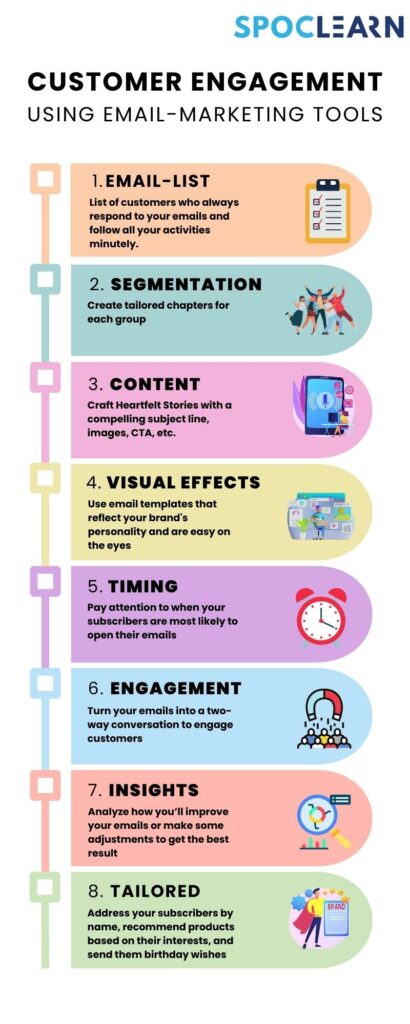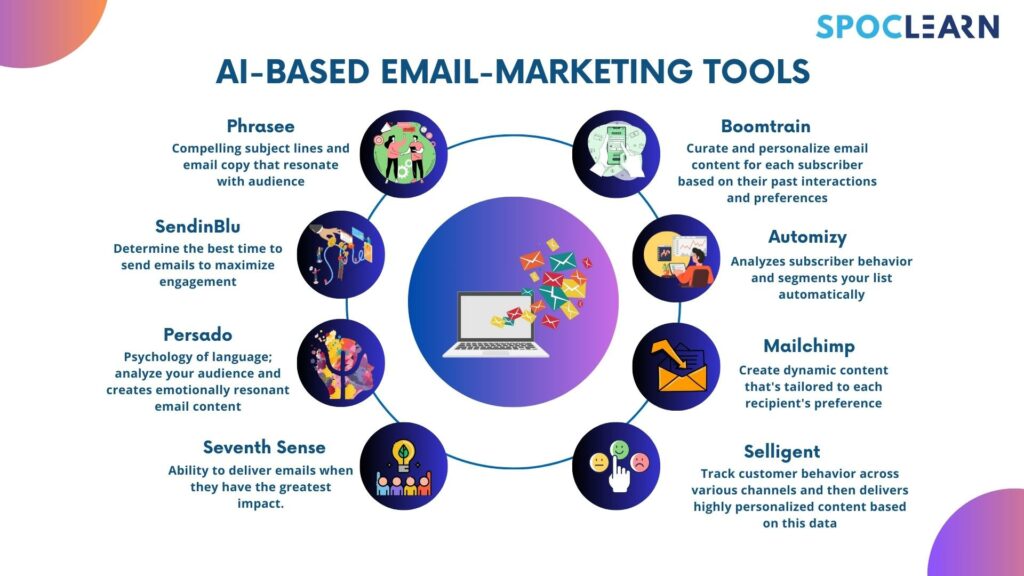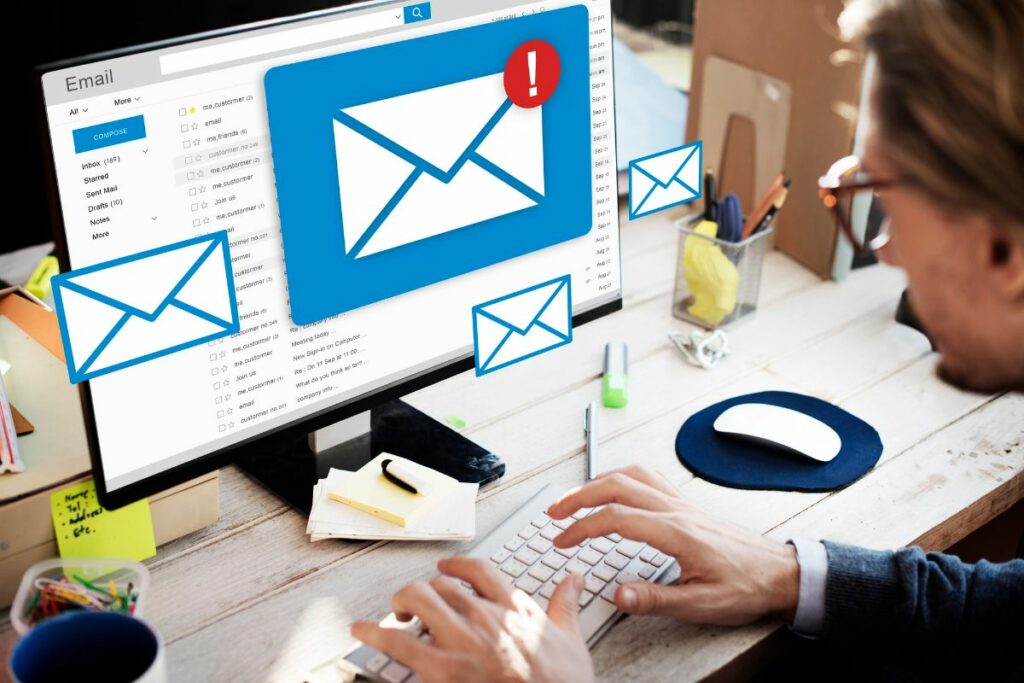Table of Contents
ToggleThe most effective Email Marketing campaigns are capable of more than simply conveying information about upcoming sales, new products, or upcoming events. In the digital age, numerous competitors and nearly as many email marketing efforts are vying for your customer’s attention. Email marketing has already become an effective tool to proliferate the business and a wholesome Digital Marketing Course will help you go through it.
Major industries That Rely on Email marketing
Email marketing tools can work wonders for a variety of industries. While it’s true that almost any business can benefit from it, certain industries stand out and shine when it comes to reaping the rewards of email marketing magic. So, let’s have a cozy chat about which industries are like a fish in the water when it comes to email marketing, and why they flourish in this space while driving sales like never before.
- E-Commerce and Retail – Ah, the shopping haven! E-commerce and retail businesses have a treasure trove of products to showcase, and email marketing is like their trusted map to guide customers through the aisles. With personalized recommendations, order updates, and exclusive deals, emails create a sense of excitement. Imagine receiving an email with “Your Wishlist is on Sale!” – who could resist? It’s like having a personal shopper right in your inbox. Plus, abandoned cart emails work wonders in reminding shoppers about that dress they left hanging in the digital cart, gently nudging them to complete their purchase.
- Travel and Hospitality – The wanderlust-inducing world of travel and hospitality is a perfect fit for email marketing. Imagine receiving dreamy destination suggestions, travel deals, and enticing vacation packages right in your inbox. These emails paint a picture of memorable experiences waiting to be lived. Whether it’s a “Last-Minute Getaway” offer or a “Plan Ahead for the Holidays” email, they cater to our inner explorers and make us want to pack our bags immediately, a massive benefit of email marketing!
- Food and Beverage – Let’s talk about our taste buds! Email marketing is a mouthwatering medium for food and beverage businesses. Think about receiving delectable images of new menu items, weekly specials, or even recipes to try at home. These emails engage our senses and turn us into hungry fans. Ever gotten a “Free Dessert with Your Next Meal” email? It’s like a golden ticket to flavor town, and who can resist a free treat?
- Health and Wellness – Taking care of ourselves is a priority, and the health and wellness industry knows it. Emails from this sector are like a friendly nudge in the direction of well-being. Whether it’s workout tips, nutritious recipes, or exclusive gym membership offers, these emails inspire us to stay healthy. A “New Year, New You” email campaign, for instance, perfectly aligns with our resolution to hit the gym and eat better.
- Media and Entertainment – Lights, camera, email! The media and entertainment industry knows how to keep us hooked. With emails about upcoming movie releases, concerts, or streaming recommendations, they make sure we’re always in the loop. Special previews, early bird access, and behind-the-scenes content are their secret ingredients to maintaining our interest and excitement. They use a brilliant technique called re-marketing where they can track your watch history and create alluring emails so that you continue to enjoy their product or service.
- Tech and Gadgets – Ah, the ever-evolving world of technology. Email marketing here is like unwrapping a gift of the future. From “New Product Launch” emails to “Limited-Time Tech Deals,” they let us know about the latest gadgets and innovations. Exclusive offers, product demonstrations, and informative content turn these emails into an exciting digital playground. Successful email marketers always implement a chic yet impactful email marketing strategy so as to create an other-worldly impression!
Ways to Improve Email Marketing Engagement
- Eye-catching content – Write an email that’s short, eye-catching, and easy to read. Use attractive visuals, smart copy, and an easy-to-understand call to action. Make sure to tell a story, give value, and address your recipient’s needs or wants. You can also employ user-generated email content like testimonials or case studies to help build trust. Nearly two out of three marketers use email marketing to distribute content organically and the number is spiking drastically.
- Stability and frequency – Email frequency is an essential factor in building trust and familiarity with a brand. However, it is important to strike a balance between providing regular updates and not overwhelming your subscribers. To determine the right frequency for your audience, it is beneficial to monitor engagement metrics.
- Captivating subject lines – Your subject title is the first thing people see when they open your email. It should be well-created, short, and relevant to what you are trying to say. A good subject line picks people’s interest and gets them to open your email to find out more. Don’t be afraid to use emoticons, numbers, and language that’s focused on action to stand out in a sea of inboxes. According to research conducted by a reputed organization, the number of email users was approximately 4.3 billion in the year 2022 and the forecast says that it will increase to 4.6 billion by 2025.
- Call to Action – Think of the CTA as a roadmap for your reader’s next step. Without a CTA, your email might be interesting, but it might not lead to any specific action. The CTA bridges that gap by telling your readers exactly what you’d like them to do. It’s like whispering, “Hey, come this way!” Whether it’s accessing exclusive content, snagging a deal, promotional emails, or gaining valuable information, the CTA promises something worth exploring.
- Thank-you emails -Showing gratitude to your customers makes them like you and your brand. Sending a thank-you email is a thoughtful and elegant way to express your gratitude to each and every one of your customers. For example, the company Bombas has donated 3 million pairs of socks, and they could not have achieved this success without the support of their customers. Therefore, they sent a thank-you email to their customers, with an added element of surprise. This way, customers feel happy, and you have fewer chances of losing them for future purchases.
- Build your email list – Capture customer and potential customer email addresses through a variety of methods, such as website forms, point of sale, social media, and contests or giveaways. Website forms can be used to encourage website visitors to subscribe to newsletters or updates; point of sale can be used to request customers’ email addresses during checkout; and social media can be used to incentivize followers to subscribe to emails.
- Automate your campaigns – Utilizing email marketing automation tools can significantly improve the efficiency of your email marketing campaigns. For example, automated welcome emails can be sent to new subscribers, as can follow-up emails sent to customers who have left their shopping cart.
Additionally, email marketing automation can be used to segment your audience, allowing for tailored email campaigns based on customer behavior, demographic data, and prior purchases. For example, if a customer segment frequently purchases a specific product, an email campaign can be created to send targeted promotions or product updates related to that customer’s interests. - Monitor and adjust – Gain insight into the performance of your email marketing campaigns through the use of email marketing metrics. These metrics may include the number of open emails received, the number of clicks, the number of bounces, and the number of conversions. Over time, these metrics can be monitored to gain insight into trends and patterns. This data can then be used to refine your marketing strategy, enhance your campaigns in the future, and determine your return on investment (ROI).
How to Use Email Marketing Tools to Improve Customer Engagement?
Digital Marketing is the new normal and understanding the nitty-gritty of this will help you in various domains. Engaging content using various methods will help you grow your business like a pro. Spoclearn helps you acquire multiple Digital Marketing tricks and tools. Here are 8 steps to guide you through the journey –

Step 1: Gather Your Tribe – Build Your Email List
Imagine your email list as a cozy circle of friends who can’t wait to hear from you. Use sign-up forms on your website, social media, and even physical stores to invite people into your email family. Offer something special in return, like a discount or a freebie, to make joining the club irresistible. This way, you’re ensuring that everyone who receives your emails is genuinely interested in what you have to share.
Step 2: Know Your People – Segment Your List
Just like in a good story, not everyone wants the same thing. Segmenting your list is like creating tailored chapters for each group. Dividing your subscribers based on preferences, purchase history, or location lets you send them content that truly resonates. Imagine sending hiking gear offers to outdoor enthusiasts and spa day promotions to wellness seekers – that’s the magic of personal connection!
Step 3: Craft Heartfelt Stories – Compelling Content Creation
Now, it’s time to create content that speaks from the heart. Think of your emails as little stories you’re sharing with friends. Whether it’s a vibrant newsletter, an exclusive sneak peek, or a heartfelt “thank you,” your content should bring value, joy, or solutions to your subscribers. Engage them with captivating subject lines that ignite curiosity, like a friend whispering a secret in their ear.
Step 4: Visual Magic – Eye-Catching Designs
Imagine your emails as beautifully wrapped gifts. Visual appeal matters! Use email templates that reflect your brand’s personality and are easy on the eyes. Incorporate images that tell a story and guide the reader through the email. A balanced mix of text and visuals makes for a delightful reading experience – just like flipping through a captivating magazine.
Step 5: Timing is Everything – Send Thoughtfully
Just like inviting friends over for tea, timing matters. Pay attention to when your subscribers are most likely to open their emails. Maybe it’s during their morning coffee or a quiet evening. Testing different send times can help you discover the sweet spot when your emails receive the warmest welcome.
Step 6: Interactive Charm – Engaging Elements
Imagine adding a touch of playfulness to your emails, like a surprise element in a greeting card. Interactive content, like polls, quizzes, or GIFs, invites subscribers to participate. It’s like turning your emails into a two-way conversation where they can’t help but get involved. This kind of engagement fosters a sense of belonging and excitement.
Step 7: Analyze and Adapt – Learning from Insights
Think of your email journey as an ongoing conversation. Email marketing tools provide insightful data, showing you what’s working and what needs a little adjustment. Dive into open rates, click-through rates, and subscriber behavior. Maybe your subscribers love “How-To” guides more than product announcements. Use these insights to refine your approach and keep the engagement fire burning.
Step 8: Personalized Magic – Tailored Experiences
Imagine receiving an email that feels like it was meant just for you. Personalization adds that sprinkle of magic. Address your subscribers by name, recommend products based on their interests, and send them birthday wishes. This level of care creates a bond that’s stronger than ever. It’s like a warm hug in digital form. A recent report highlighted that emails with personalized messages or content generate 50% higher open rates.
AI-based Email-Marketing Tools
AI-powered email marketing tools are all the buzz these days! They’re like having a magical assistant that helps you create, optimize, and personalize your email campaigns. A report stated that in 2022 alone, the number of emails that were received and sent globally was 333.2 billion daily, and in 2025, it will be around 376.4 billion in 2025 as the prediction reflects. Here are a few trending AI email marketing tools and how they work their enchantment:

- Phrasee: Think of Phrasee as your language wizard. It uses AI to generate compelling subject lines and email copy that resonate with your audience. It analyzes past campaign performance and learns which phrases and tones work best. This tool is effective because it takes the guesswork out of crafting engaging content, increasing open and click-through rates.
- SendinBlue: SendinBlue’s AI-powered algorithms help you determine the best time to send your emails to maximize engagement. It considers your audience’s behavior patterns and sends emails when they’re most likely to be active. This tool is effective because timing is crucial in email marketing, and sending emails at the right moment can significantly boost open rates.
- Persado: Persado taps into the psychology of language. It uses AI to analyze your audience and creates emotionally resonant email content. By selecting words and phrases that evoke specific emotions, Persado increases the emotional connection between your brand and subscribers, leading to higher engagement and conversions.
- Seventh Sense: Just like a clock that knows your schedule, Seventh Sense optimizes send times for each individual subscriber. It uses AI to analyze recipient behavior, like when they open emails, and then sends messages when they’re most likely to engage. This tool’s effectiveness lies in its ability to deliver emails when they have the greatest impact.
- Boomtrain: Boomtrain is like your personal email stylist. It uses AI to curate and personalize email content for each subscriber based on their past interactions and preferences. This level of personalization enhances engagement because it feels like the emails are tailored just for the recipient.
- Automizy: Automizy’s AI-powered segmentation analyzes subscriber behavior and segments your list automatically. It ensures that your emails reach the right people with the right content. This tool’s effectiveness lies in its ability to deliver highly relevant content, which leads to improved engagement and higher conversion rates.
- Selligent: Selligent’s AI capabilities extend beyond email marketing. It uses machine learning to track customer behavior across various channels and then delivers highly personalized content based on this data. By providing a cohesive and personalized experience, Selligent helps boost customer engagement and loyalty.
- Mailchimp: Mailchimp’s AI-powered features, like product recommendations, help you create dynamic content that’s tailored to each recipient’s preferences. By suggesting products similar to ones customers have previously shown interest in, Mailchimp increases the chances of driving conversions and engagement.
Conclusion
The AI revolution has added a layer of enchantment to email marketing. From optimizing send times to generating compelling subject lines, AI-powered tools ensure that each email resonates with recipients. Insights driven by machine learning refine strategies, enhancing open rates, click-through rates, and overall engagement. Exclusivity is the golden ticket to heightened engagement.
By offering unique deals, sneak peeks, or tailored rewards, brands create a sense of privilege for subscribers. As brands continue to embrace the art of personalized storytelling, interactive content, AI insights, and the allure of exclusivity, the email landscape evolves into a realm of enchantment where customers don’t just read emails – they eagerly engage with them, forging enduring relationships along the way.
FAQs
1. How does personalization in email marketing boost customer engagement?
Answer: Personalization tailors emails to individual recipients’ preferences, making them feel understood and valued. This results in higher open and click-through rates, as subscribers are more likely to engage with content that’s relevant to them.
2. Can emojis enhance customer engagement in emails?
Answer: Yes, emojis add a touch of playfulness and emotion to your emails, making them stand out in crowded inboxes. They help convey feelings and catch the reader’s eye, ultimately leading to increased engagement.
3. How does storytelling improve engagement in email campaigns?
Answer: Storytelling creates an emotional connection with recipients. When emails tell a relatable and compelling story, subscribers are more likely to read the entire message, increasing the chances of them engaging with the CTA.
4. What’s the role of user-generated content in email engagement?
Answer: Including user-generated content in emails, such as reviews or social media posts, builds trust and authenticity. It showcases real experiences, making subscribers more likely to engage with the content and trust your brand.
5. How does interactive content impact customer engagement in emails?
Answer: Interactive elements like polls, quizzes, and GIFs make emails more engaging and encourage subscribers to interact directly with the content. This hands-on experience creates a deeper connection and longer time spent with the email.
6. Can AI-driven send time optimization make a difference in engagement?
Answer: Absolutely. AI analyzes recipient behavior to determine the optimal time for sending emails. By reaching subscribers when they’re most likely to be active, open rates increase, resulting in higher engagement.
7. How do drip email campaigns contribute to prolonged engagement?
Answer: Drip campaigns deliver emails over time, nurturing the subscriber relationship. By providing relevant and valuable content gradually, you maintain consistent engagement and build a stronger connection.
8. Why is creating a sense of exclusivity important for engagement?
Answer: Exclusive offers or sneak peeks make subscribers feel valued and special. When recipients know they’re getting something unique, they’re more likely to engage and take advantage of the opportunity.
9. Can gamification elements really make emails more engaging?
Answer: Absolutely. Gamification elements like scratch-and-win games or interactive puzzles create a fun experience within the email. Subscribers engage to uncover rewards, making the email memorable and enjoyable.
10. How does email integration with social media enhance engagement?
Answer: Integrating social media buttons in emails allows subscribers to easily share interesting content. This extends your email’s reach, generates social proof, and brings in new engaged audiences.
